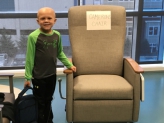Novel Nanoscale Phosphoproteomic Discovery of Therapeutic Targets in AML Stem Cells

Dr. Wang has moved and will be continuing his research at City of Hope's Beckman Research Institute in Duarte, CA. http://www.leowanglab.org/
Background
Acute myeloid leukemia (AML) is difficult to treat, relapses easily, and is often fatal. This is largely due to the existence of rare leukemia stem cells (LSCs), which are able to propagate the disease but are resistant to chemotherapy. Developing therapies that specifically target LSCs will improve AML cure rates dramatically.
To eradicate AML LSCs, we need to identify how they maintain "stemness" - the ability to regenerate themselves indefinitely, unlike normal AML cells that divide a certain number of times and then die. Stemness is a feature that LSCs share with hematopoietic stem cells (HSCs), which are the blood progenitor cells responsible for differentiating into all the normal blood cells in the body over a lifetime.
Project Goal
Comparing the active pathways shared by LSCs and HSCs but absent in other AML cells will identify candidates responsible for LSC stemness; these can then be targeted to eliminate LSCs. Because proteins are the effectors of almost all cellular functions, this comparison should be done at the protein level. However, only very recently have technical advances allowed the proteomic (protein-level) analysis of rare cell populations like LSCs and HSCs. We have developed unique technologies and have expertise available nowhere else in the world, allowing us to undertake proteomic analyses of pure populations of rare cells. Using these and other advanced techniques, we will generate a unique activated proteomic signature responsible for LSC stemness, identifying candidates for further experiments in which pharmacologic interventions can be designed, tested, optimized, and developed into new leukemia cures.
Project Update (June, 2016)
In children, AML can only be cured about 60% of the time, largely because of a subpopulation of cancer cells known as leukemia stem cells (LSCs) that make up a very small fraction of the leukemia cells at diagnosis but are highly resistant to chemotherapy. These cells survive conventional treatment to cause relapse and death. Discovering ways to target and kill these LSCs will improve AML cure rates drastically. With the crucial support of the Alex's Lemonade Stand Foundation, I have made tremendous advances towards this goal. Over the past year, I have implemented a new way of dissecting AML cells to identify unique features that can be targeted to improve therapy for this disease. Application of this new technology will reveal pathways that are uniquely activated in LSCs but not in other types of cells (either normal stem cells, or in leukemia cells that are not stem cells). I have extensively tested this new method and confirmed its power and precision in mouse models, and have piloted this system in human AML with promising preliminary results. The accomplishments of the past year have given me clear direction, identifying ways to improve our platform which will permit me to unlock the secrets through which human AML stem cells escape therapy. I expect that the results of my next experiments will generate data that will be of immense clinical benefit.

